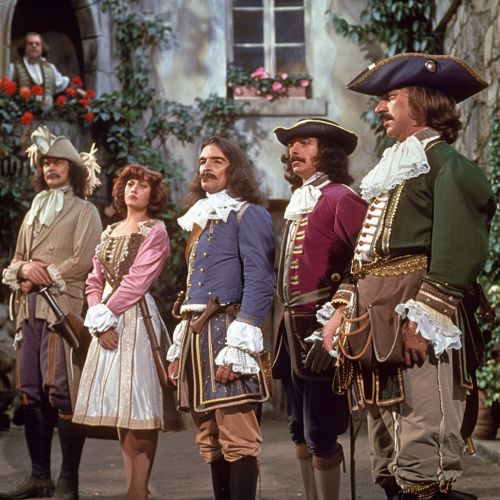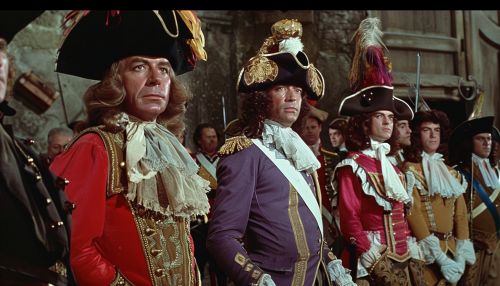The Three Musketeers (1973 film)
The Three Musketeers (1973 film)


Introduction
The Three Musketeers is a 1973 film adaptation of Alexandre Dumas' 1844 novel The Three Musketeers. Directed by Richard Lester, the film is notable for its comedic tone and its faithfulness to the original source material. The screenplay was written by George MacDonald Fraser, who is known for his historical novels. The film features an ensemble cast including Michael York as D'Artagnan, Oliver Reed as Athos, Frank Finlay as Porthos, Richard Chamberlain as Aramis, and Raquel Welch as Constance Bonacieux.
Plot
The film follows the adventures of a young and ambitious D'Artagnan, who leaves his home in Gascony to join the Musketeers of the Guard. Upon arriving in Paris, he quickly becomes entangled in the political intrigues of the court of Louis XIII, the machinations of Cardinal Richelieu, and the schemes of the villainous Milady de Winter.
D'Artagnan's journey begins with a series of duels that introduce him to the titular three musketeers: Athos, Porthos, and Aramis. The four become fast friends and allies, committed to the motto "All for one, and one for all." Together, they navigate a series of adventures that involve thwarting Richelieu's plans to undermine the Queen, recovering the Queen's diamonds, and dealing with the treacherous Milady de Winter.
Cast and Characters
- Michael York as D'Artagnan: A young and inexperienced but highly skilled swordsman who dreams of becoming a musketeer.
- Oliver Reed as Athos: The most stoic and melancholic of the three musketeers, hiding a tragic past.
- Frank Finlay as Porthos: The most flamboyant and jovial musketeer, known for his love of luxury.
- Richard Chamberlain as Aramis: The most pious and scholarly of the musketeers, who harbors ambitions of becoming a priest.
- Raquel Welch as Constance Bonacieux: The Queen's seamstress and D'Artagnan's love interest.
- Charlton Heston as Cardinal Richelieu: The primary antagonist, a cunning and manipulative statesman.
- Faye Dunaway as Milady de Winter: A beautiful but deadly spy and assassin in the service of Richelieu.
- Geraldine Chaplin as Queen Anne: The Queen of France, whose honor the musketeers strive to protect.
- Jean-Pierre Cassel as King Louis XIII: The somewhat ineffectual King of France.
Production
The film was produced by Ilya Salkind and Alexander Salkind, who later became famous for producing the Superman film series. The screenplay by George MacDonald Fraser aimed to capture the wit and humor of Dumas' original novel, while also incorporating swashbuckling action sequences.
Filming Locations
The film was shot on location in various historical sites across Spain, including the Royal Palace of La Granja de San Ildefonso, the Alcázar of Segovia, and the Castle of Belmonte. These locations were chosen for their authentic period architecture, which added to the film's historical accuracy.
Costume Design
The costumes were designed by Yvonne Blake, who won an Academy Award for her work on the film. Blake's designs were noted for their historical accuracy and attention to detail, which helped to immerse the audience in the 17th-century setting.
Reception
Upon its release, The Three Musketeers received positive reviews for its blend of action, comedy, and historical drama. Critics praised the performances of the ensemble cast, particularly Michael York and Oliver Reed. The film was also lauded for its faithful adaptation of Dumas' novel, capturing both the spirit and the letter of the original text.
The film was a commercial success, leading to the production of a sequel, The Four Musketeers, which was released in 1974. The sequel continues the story from where the first film left off, adapting the latter part of Dumas' novel.
Legacy
The Three Musketeers (1973) is often regarded as one of the best adaptations of Dumas' novel. Its influence can be seen in subsequent adaptations of the story, both in film and television. The film's success also helped to revive interest in swashbuckling adventure films, a genre that had waned in popularity by the early 1970s.
The film's comedic tone and ensemble cast have been cited as inspirations for later films, including Pirates of the Caribbean: The Curse of the Black Pearl. Additionally, the film's approach to blending humor with historical drama has been emulated in various other period films.
